Books Around the World
When we go the library, we see lots of books. Some are big; some are small. Some
have pictures; some don't. They are different sizes and shapes and are about
different things, but all the books are made the same way. The books with hard
covers are made with folded pages that are held together by stitches on the
inside. The paperback books are held together with glue.
Are these the
only ways to make books? Absolutely not.
Books can be made of pages that are tied together, strung on strings, folded,
rolled, and sewn in different ways. Today we use paper to make books but when
people first started writing, there was no paper. They used whatever materials
they could find around them- wood, leaves, clay, cloth, bark, metal, and animal
skin. The way the pages were put together depended on the material being used.
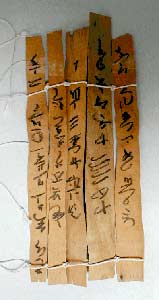

Slat
Book
Slat books, or jian ce, were the first kind of book made in China. They were made of strips of
wood or bamboo that were held together by cord. This is where the Chinese custom
of writing from top to bottom began. The books were rolled, or folded like an
accordion, when they were stored on shelves in libraries. Since slat books have not been made since the 4th century, I made this example by copying a picture of an inventory or list of weapons that was made in 79 BC during
the Han Dynasty.
Watch a video about Chinese calligraphy here.
Palm Leaf Books
Books made from the leaves of palm trees were first made in India and then in Indonesia and Southeast Asia. The long, narrow shape of the page comes from
the shape of a palm leaf. The leaves are boiled in water or milk to make them
stiff and strong. The pages have holes in them. They are strung on cords with
knots or coins at either end to hold them together. In the photos, I have spread
the pages out so you can see more of them. If you were reading the book, you
would hold the pages in a stack and flip one page at a time.
Palm Leaf Book from Thailand
This book came from a shop in Thailand that sells things for people who are learning to be Buddhist monks. Buddhism is the
main religion in Thailand. The person who
bought it for me said it was a parable (a story that teaches a lesson) about a
frog. When I showed it to a Cambodian Buddhist monk, he said it was Buddhist
poetry. Since I can't read the language, I don't know which is correct. The writing in this book is printed by
machine.
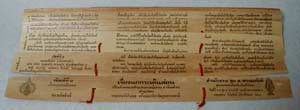
For more information about how palm leaf books are made click here.
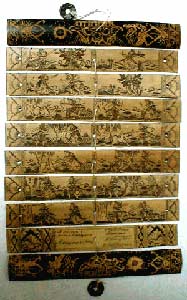

Palm Leaf Book from Bali, Indonesia
This picture book tells part of the
Ramayana, a Hindu story about the god Rama, his girlfriend Sita, and his brother
Lakshman. There are pictures on the front of each page and writing on the back. A
stick with a needle in the end was used for drawing and writing. After scratching
the pictures and writing into the surface, ink was rubbed over the page. It went
into all the scratches. The extra ink was then wiped off the top surface. Isn't
the detail amazing?
Read the story here.
Papyrus Scroll from Egypt
I bought this piece of papyrus from Egypt at a flea market. It's new, but I have it as an example of an ancient Egyptian scroll which it imitates.
Scrolls were made in ancient Egypt from papyrus, which is made from the papyrus
plant that grows in the Nile River. The stems are cut and sliced into thin
strips which are laid on top of each other in two layers, one horizontal and one
vertical. They are then pressed so that the layers mesh together. Our word paper
comes from the word papyrus.
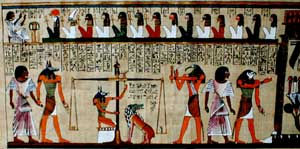
This piece is like a section of a scroll. The large pictures are the illustrations. The small black ones are hieroglyphs which was the writing in ancient Egypt. Most scrolls were much longer than this, often 25 to 50 feet long. Scrolls were also used as books in ancient Greece and Rome but there were no pictures, just writing. Scrolls are also made of different materials around the world: silk and paper in China, Japan, and Korea, leather in Israel, Africa, and the Middle East, birchbark by some Native American tribes. I've even seen pictures of scrolls made of gold from India.
You can translate your name or a phrase into hieroglyphs, here.
You can see a short video from the Science Channel about making papyrus here.
Accordion
Book from China
I purchased this one in Chinatown in Boston. It is written in Chinese and English and is called Long Established Customs at Chinese Festivals. The illustrations are on paper with a cloth border around each one.
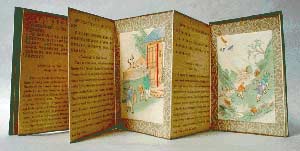
You can find out more about Chinese festivals and holidays
here.
Accordion Book from Mexico
Accordion books were made in Mexico and Central America by the Maya and the Aztecs. Their books were made from deerskin or amate, a paper made from the inner bark of trees. In Mexico, in the village of San Pablito, they still make the paper today in the same way. Strips of the inner bark are boiled in lye to soften them, then laid on a stone in two layers, one horizontal and one vertical. They are beaten with a stick until the fibers mesh together and form the paper.

This book was made by Sr. Alfonso Garcia Tellez who is the shaman of the village. He performs ceremonies with the cut out amate figures and makes books about them. This book is An Offering to Bring the Rain which is about figures used to bring the rain and make the crops grow. The figures are gods of different plants. You can see the Dios de Pina, the God of the Pineapple, in the picture.
Watch video to see how amate paper is made here.
Sewn Books from China and Japan
This style of sewn books was first made in China, then spread to Japan, Korea,
and Vietnam. These books have soft covers and you can see the stitches on the
outside of the book. The book is made by stacking folded pages and sewing them together along the open edge. The reason for this style of binding was because the writing was done with a brush and ink on thin paper.
Since the ink could bleed through the thin paper, the writing could only be done on one side of the paper. Notice the way the books open. They open in the opposite
direction from western books because Chinese is written from right to left.
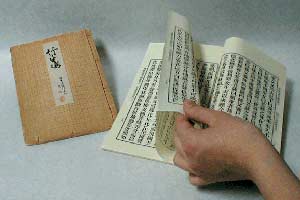
The closed book is from Japan and contains the text for a Noh play.
The open book is a Buddhist book from the Mahayana Buddhist Temple in South
Cairo, New York.
You can find out more about Noh drama here.
Sewn Books from Europe
The early sewn books in Europe had pages made from animal skin and covers made of wood. Sections of vellum (calfskin) or parchment (sheep or goat) were folded in half and sewn along the fold. This one is made from vellum which is calfskin. These books are the direct ancestors of the books we use today.

Shown here is a page from a Choir Book that was made in Spain in about 1600 and used by monks in a monastery for singing. I bought it at an Antiquarian Book Fair in Boston. The writing was done with a reed pen. The square marks are the notes. The words are in Latin which was the language used by the ancient Romans. It was used in Roman Catholic churches until about 30 years ago. Do you see any words you know? Have you ever heard a song with Alleluia in it? It's on lines 4 and 5 and means Praise Ye the Lord.
Learn how to make an illuminated letter here.
Back to Top
© 1999-2021 Susan Kapuscinski Gaylord
skgaylord (at) makingbooks.com
www.makingbooks.com
|